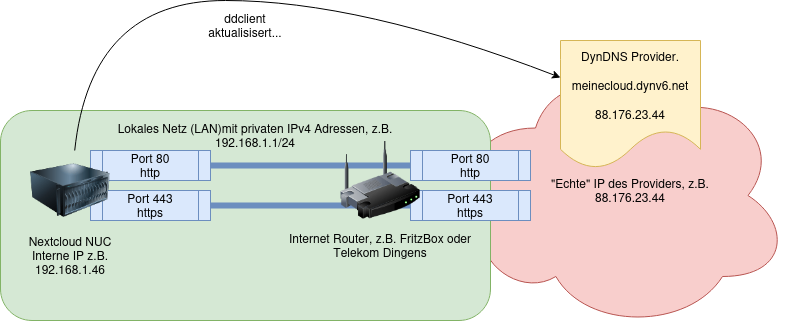Inhaltsverzeichnis
Freigabe ins Internet
Zertifikate
- Zertifikate kann man nur erhalten, wenn man einen DNS Namen hat, z.B. wolke.qg-moessingen.de. der Host muss auf Port 80 und Port 443 erreichbar sein.
- Problem: Die IP-Adresse an einem Hausanschluss ändert sich gelegentlich.
- Lösung: Ein „Dyndns“ Provider, z.B. dynv6.com
DynDNS mit dynv6.com
- https://dynv6.com/ öffnen und einen Host/Domainnamen wählen - gültige Mailadresse angeben.
- Bestätigungsmail öffnen, Bestätigungslink anklicken
- Melde dich bei dynv6.com an
- Auf dem Nextcloud Server das Paket ddclient installieren:
apt install ddclient. Alle Rückfragen kann man zunächst bei der Installation mit Enter leer lassen und bestätigen. - Editiere die Datei
/etc/ddclient.conf:
ssl=yes protocol=dyndns2 use=web, web=ipify-ipv4 server=dynv6.com login=none password='DEIN_TOKEN_AUS_DEINEM_ACCOUNT' DEINHOST.DEINE.DOMAIN
Anschließend kannst du die Funktion auf der Kommandozeile testen:
ddclient -daemon=0 -debug -verbose -noquiet -force
und
ddclient -daemon=0 -debug -verbose -noquiet
Wenn das klappt, kann man den ddclient-Daemon neu starten: systemctl restart ddclient.service, mit journalctl -f -u ddclient kann man die Meldungen des Daemons im Log anschauen.
Portweiterleitung am Router
- Demo an den PT mit der Fritz Box der Schule.
- Port 80 und 443 sollten an die interne IP-Adresse der Cloud weitergeleitet werden.
Zertifikat erhalten mit mod_md
- Mod-MD Paket installieren:
apt install libapache2-mod-md - SSL und Mod–MD bei apache anschalten:
a2enmod ssl mdundsystemctl restart apache2 * Nun muss man die Datei/etc/apache2/sites-enabled/000-default.conf'' anpassen, so dass sie wie unten aussieht - meinecloud.dns.army muss dabei alletrdings durch einen DynDNS Namen ersetzt werden.
ServerName meinecloud.dns.army
MDomain meinecloud.dns.army
MDContactEmail certifica@ua25.de
MDCertificateAgreement accepted
MDPrivateKeys RSA 4096
<VirtualHost *:80>
# The ServerName directive sets the request scheme, hostname and port that
# the server uses to identify itself. This is used when creating
# redirection URLs. In the context of virtual hosts, the ServerName
# specifies what hostname must appear in the request's Host: header to
# match this virtual host. For the default virtual host (this file) this
# value is not decisive as it is used as a last resort host regardless.
# However, you must set it for any further virtual host explicitly.
#ServerName www.example.com
ServerAdmin webmaster@localhost
DocumentRoot /srv/nextcloud
<Directory "/srv/nextcloud">
AllowOverride all
Require all granted
</Directory>
# Available loglevels: trace8, ..., trace1, debug, info, notice, warn,
# error, crit, alert, emerg.
# It is also possible to configure the loglevel for particular
# modules, e.g.
#LogLevel info ssl:warn
ErrorLog ${APACHE_LOG_DIR}/error.log
CustomLog ${APACHE_LOG_DIR}/access.log combined
# For most configuration files from conf-available/, which are
# enabled or disabled at a global level, it is possible to
# include a line for only one particular virtual host. For example the
# following line enables the CGI configuration for this host only
# after it has been globally disabled with "a2disconf".
#Include conf-available/serve-cgi-bin.conf
</VirtualHost>
<VirtualHost *:443>
# The ServerName directive sets the request scheme, hostname and port that
# the server uses to identify itself. This is used when creating
# redirection URLs. In the context of virtual hosts, the ServerName
# specifies what hostname must appear in the request's Host: header to
# match this virtual host. For the default virtual host (this file) this
# value is not decisive as it is used as a last resort host regardless.
# However, you must set it for any further virtual host explicitly.
#ServerName www.example.com
ServerAdmin webmaster@localhost
DocumentRoot /srv/nextcloud
<Directory "/srv/nextcloud">
AllowOverride all
Require all granted
</Directory>
# Available loglevels: trace8, ..., trace1, debug, info, notice, warn,
# error, crit, alert, emerg.
# It is also possible to configure the loglevel for particular
# modules, e.g.
#LogLevel info ssl:warn
ErrorLog ${APACHE_LOG_DIR}/error.log
CustomLog ${APACHE_LOG_DIR}/access.log combined
# For most configuration files from conf-available/, which are
# enabled or disabled at a global level, it is possible to
# include a line for only one particular virtual host. For example the
# following line enables the CGI configuration for this host only
# after it has been globally disabled with "a2disconf".
#Include conf-available/serve-cgi-bin.conf
SSLEngine on
</VirtualHost>
